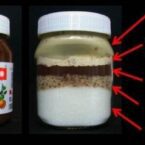If you’re a cat lover and you care for them not to get hurt or to freeze when it’s too cold outside, why not providing them a shelter for the cold season? It’s easy to make and very useful for the cats during the cold season. Following the steps from the photo, you may realize such a shelter. What you need are two boxes, a smaller and a bigger one, and some hay. How does it look ? ..





















one problem with this design is that there is only one hole. Great for keeping in the body heat of the cat, however, if anything wilder than a cat, a racoon, a bobcat, a fox, a possum, and many other critters find the cat in this “shelter” with no escape route other than to come out facing the attacker. . .well it’s not gonna turn out well for the cat. You need an escape hole out the back or side. It is well worth the heat loss. I lost a cat to a possum this way. . .
@Kay O’Neil, if you only lightly place the lid on top, the cat can jump out. On the cheaper priced containers the lids dont stay on well anyways. I wouldnt make another hole because the point is to keep them from being cold. I also wouldnt leave my cat outside 🙂
I care for a colony of feral community cats. You can’t bring a feral cat inside. I’m not sure they would even go inside one of these. I tried putting a styrofoam cooler out last winter. It was never used. One of the cats now lounges on top of it, in Snoopy fashion.
Also in some countries like mine there are no other bigger mammals around, maybe someone from this area has made this…
Whoa! Ever penned a cat into somewhere it didn’t want to be? They’re meaner than a mama bear. Don’t underestimate your fuzzy little playmate.
foxes are affraid of cats, usually
A few years ago, I made one these shelters for an outside ‘orphan’ cat which took up residence on my porch. Okay, I did start feeding it. 🙂 I chose a storage container big enough to accommodate one of those enclosed cloth-type cat beds that has a hole in the front. My husband cut a hole in one end of the the plastic storage container a little bigger than the hole in the cloth cat bed. I placed the cloth cat bed in the container, added some padding (old bath towels) to fill up the space and placed the lid on it. It has worked great. I might add that I live in Wisconsin in a rural area and regularly have night visitors such as raccoons, opossums, skunks, etc. They have never bothered the cat, probably because they, more or less, “grew up together” in the wild. I also keep a covered litter box on the porch so the cat won’t have to go out in the snow to do his business.
I had the same experience, Martha. I lived outside of Chicago, and a feral cat who I was feeding got pregnant at the beginning of winter. I set up a similar box (one hole, lots of old towels to burrow into) and set it under my deck, and she took me up on my offer and moved in. Nighttime visitors included ‘possums and skunks, and nobody messed with her. Of course, the day after she gave birth, one of the kittens fell out into the snow, so I carted them all indoors… and the rest of the story is that “MammaKitty” is still with me and is now 18 years old, and her kittens became domesticated, neutered house cats. I agree that it is possible that a predator could trap a kitty, but in my experience, I think everyone was smart enough to stay away from a protective mother cat.
If we tacked a piece of carpeting at the top to fit the cut area, it would insulate and be flexible enough as a cat door. This is done in racing greyhound kennels as an inexpensive alternative to a rubber flap since the poor, bored dogs chew through a dog door in a couple of days.
Towels, cloths etc. drain heat out of kitties’ bodies in cold weather. Straw doesn’t. A container like shown above is perfect.
Instead of fiber/towels, etc. which get wet & stay wet, use straw which is very warm & lets water on cat coat drip down to bottom without keeping bed wet. It can then be later refreshed by new straw.
this would be awesome for bunnies who live in the neighbourhood
I think its an awesome idea & I’m planning on doing it for all the strays by my house. Thank you.
Wouldn’t using straw as insulation invite parasites to take up residence in the box as well? I think I would use something like an old blanket or towel instead so I could wash it.
Straw (not hay) is hollow and is a very good insulator. If it does get damp, from snow or rain tracked in, it dries faster than towels which can hold the moisture…say at night when you are sleeping which means the cat is lying on cold wet towels. The straw can be re arranged by the cat to make a dry area. As far as parasites, use some flea and tick powder or spray early in the season to get rid of the pests..
Do you think shredded paper from a paper shredder would work for insulation?
This is a great inexpensive way to keep
Your neighborhood ferals/strays warm in the winter. Always use straw as the bedding/ insulation, and use a thinner foam type insulation between the two bins for good insulation. Straw (not hay) is the best as it dries out the quickest. Towels are dangerous to use, as they will freeze in the winter if they get wet/damp. Plain old straw packed in will keep them the warmest and they can still burrow/ make their bed.
Straw is ideal because it can be dumped in the compost heap. You would likely buy a bail of straw which would leave you with a lot of extra straw if you did a couple boxes. You would have enough to switch it out a couple times a season.
Aw I love this. I have a feral cat that visits my porch. I just moved into a new apartment and I see her/him almost every day. And when I come out he/she runs off. But this is great! I have worried about her so much. I saw it’s a her because she’s so small. I have three of my own that have never stepped a toe on grass and I have a hard time thinking about her sleeping on my swing in the cold. Love, Love LOVE this! Thank you for sharing!
you can also line the boxes with thermal foil that you can buy at almost any home supply store, dollar store, etc. Gives an extra layer of wind-stopping power. Put a piece on the floor and cold is trapped underneath. Towels, blankets, etc are not a good idea. If they get wet, they hold the wet and cold and freeze.
i have a heating pad w 3 setting for my stray that lives on the deck.I use a really big plastic storage box.blankets inside under the heating pad and blankets over the plastic box.A piece of wood as the roof and a water proof tarp over this.The entrance is a covered by a really big couch pillow from my old couch.He loves it and is very cozy in there. I can see him in there when I look out to check on him.
I have been wondering if a heating pad would work and not electrocute the cat in return if it got wet or clawed into. Looks like you have a pretty good set-up for your kitty.
I would suggest using a heat mat for sprouting seedlings. They can be bought in different sizes, but the heat is one setting… about 70 degrees F. and they tolerate getting wet, because they typically have seedlings that need to be watered on them.
Please, PLEASE do not use heating pads. I had a family member who lost their house in a fire started by a heating pad that was mad for a doghouse. I know you want to keep your pets warm, but a heating pad is not a safe way.
This seems good but plastic is so cold. I have several stray cats and I went to the pet store and ask for their styrofoam lg fish containers ( the kind they ship fish in). Turned them upside down cut a hole and put padding in them and I put them up in an attic over the garage. The cats go up there. Seems to be working. And my strays eat with the opossums and raccoons.
this is a great idea ….cant wait to try it myself…just some protection for the strays.. !!!
Cats should be in a run or inside. Never outside. This would be great for in a run.
Put a hole in the back and put a flap on it that can be pushed open from the inside but will stay closed to keep the cold out.
Use straw not towels/fiber as when wet from rain, stays wet. Water from cat fur will drop down through straw but top parts stay warm & dry. Easy yo replace/clean then.
When an elderly neighbor died, her cat escaped being taken to the pound. In the dead of winter, one night I heard him crying outdoors. We made him a home on our porch using a strofoam cooler turned up-side down. We taped it together and cut out a circular door. We put towels in the bottom. He lived there we’ll into spring.